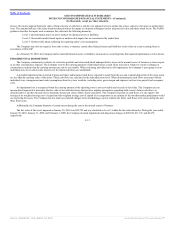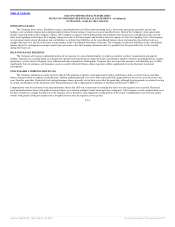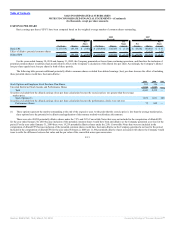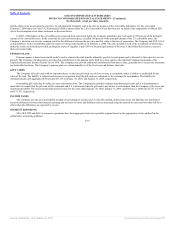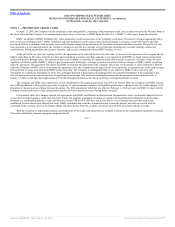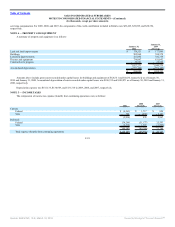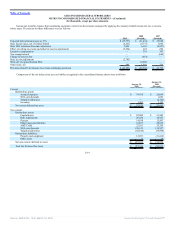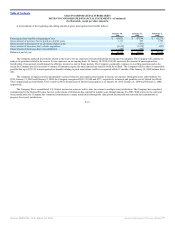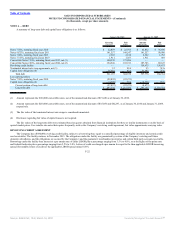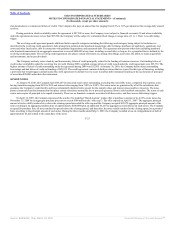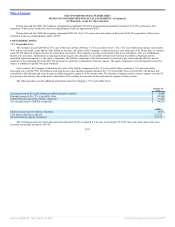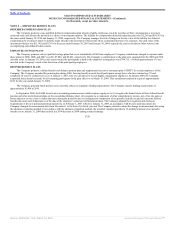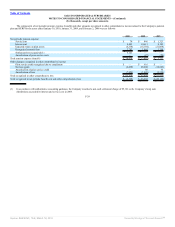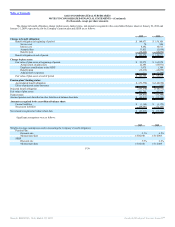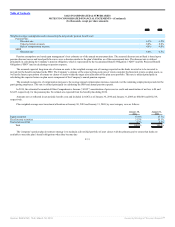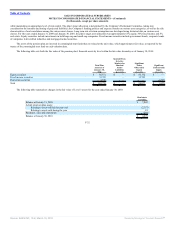Saks Fifth Avenue 2009 Annual Report Download - page 79
Download and view the complete annual report
Please find page 79 of the 2009 Saks Fifth Avenue annual report below. You can navigate through the pages in the report by either clicking on the pages listed below, or by using the keyword search tool below to find specific information within the annual report.
Table of Contents
SAKS INCORPORATED & SUBSIDIARIES
NOTES TO CONSOLIDATED FINANCIAL STATEMENTS—(Continued)
(In thousands, except per share amounts)
(for documentary or commercial letters of credit). The Company also pays an unused line fee ranging from 0.5% to 1.0% per annum on the average daily unused
revolver.
During periods in which availability under the agreement is $87,500 or more, the Company is not subject to financial covenants. If and when availability
under the agreement decreases to less than $87,500, the Company will be subject to a minimum fixed charge coverage ratio of 1 to 1. There is no debt rating
trigger.
The revolving credit agreement permits additional debt in specific categories including the following (each category being subject to limitations as
described in the revolving credit agreement): debt arising from permitted sale/leaseback transactions; debt to finance purchases of machinery, equipment, real
estate and other fixed assets; debt in connection with permitted acquisitions; and unsecured debt. The agreement also permits other debt (including permitted
sale/leaseback transactions) in an aggregate amount not to exceed $400,000 at any time, including secured debt, so long as it is a permitted lien as defined by the
revolving credit agreement. The revolving credit agreement also places certain restrictions on, among other things, asset sales, the ability to make acquisitions
and investments, and to pay dividends.
The Company routinely issues stand-by and documentary letters of credit principally related to the funding of insurance reserves. Outstanding letters of
credit reduce availability under the revolving line of credit. During 2009, weighted average letters of credit issued under the credit agreement were $25,734. The
highest amount of letters of credit outstanding under the agreement during 2009 was $52,455. At January 30, 2010, the Company had no direct outstanding
borrowings and had letters of credit outstanding of $28,525. The credit agreement contains default provisions that are typical for this type of financing, including
a provision that would trigger a default under the credit agreement if a default were to occur in another debt instrument resulting in the acceleration of principal
of more than $20,000 under that other instrument.
SENIOR NOTES
At January 30, 2010, the Company had $169,249 of unsecured senior notes outstanding, excluding the convertible notes, comprised four separate series
having maturities ranging from 2010 to 2019 and interest rates ranging from 7.00% to 9.88%. The senior notes are guaranteed by all of the subsidiaries that
guarantee the Company’s credit facility and have substantially identical terms except for the maturity dates and interest rates payable to investors. The notes
permit certain sale/leaseback transactions but place certain restrictions around the use of proceeds generated from a sale/leaseback transaction. The terms of each
senior note require all principal to be repaid at maturity. There are no financial covenants associated with these notes, and there are no debt-rating triggers.
On April 12, 2007, the Company announced the results of its modified “Dutch Auction” tender offer to purchase a portion of its 8.25% senior notes due
November 15, 2008 for an aggregate purchase price not to exceed $100 million (the “offer cap”). The offer expired on April 11, 2007. The aggregate principal
amount of notes validly tendered at or above the clearing spread exceeded the offer cap and the Company accepted $95,872 aggregate principal amount of the
notes, resulting in an aggregate purchase price of approximately $100,000 (plus an additional $3,230 in aggregate accrued interest on such notes). The Company
accepted for purchase first, all notes tendered at spreads above the clearing spread, and thereafter, the notes validly tendered at the clearing spread on a prorated
basis according to the principal amount of such notes. During the three months ended May 5, 2007, the Company recorded a loss on extinguishment of debt of
approximately $5,222 related to the repurchase of the notes.
F-23
Source: SAKS INC, 10-K, March 18, 2010 Powered by Morningstar® Document Research℠


